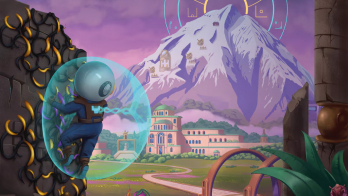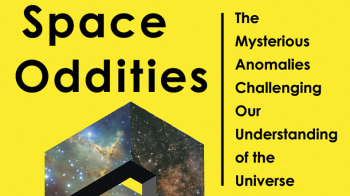CERN’s new visitor and education centre, Science Gateway, due to open this autumn, will welcome up to half a million people each year. Project leader Patrick Geeraert describes how this iconic project came about, how it will operate and what it aims to achieve.

How did the idea for Science Gateway come about?
I was on detachment at the European Southern Observatory (ESO) in Garching when I was called back to CERN in 2017. The idea for a flagship education and outreach project was already quite advanced, and since I had triggered the construction of ESO’s Supernova planetarium and visitor centre during my mandate as director of administration, the CERN Director-General (DG) thought I could build on this for CERN. There had been various projects for buildings based around the Globe in the past, but they never quite took off. However, the then-new directorate wanted to create a new space for education and outreach targeting the general public of all ages. The DG also made it clear that a large auditorium for CERN events should be part of any plan, and that the entire construction should be financed by donations. I started to work on the concept.
The Italian architect Renzo Piano had visited CERN independently and fell in love with our values. When he left, he said: “If one day I can do something for you, don’t hesitate.” A few months later he proposed to draw the building. In June 2018 he showed us his first mockup, the “space station” design you see today. It crossed the Route de Meyrin and encroached on land designated for agricultural use on the north side and the CERN kindergarten on the south side. The design complicated matters, but on the other hand it was really inspiring. My first thought was that the budget I had will not be sufficient because what is expensive when you do construction are the facades, and here we had five buildings, complicated ones, with some parts suspended. But it was so original, so much in the DNA of CERN, that we thought, okay, let it be five.
What will be in the buildings?
There are three “pavilions” and two “tubes”. On the north side of the Science Gateway, we have a 900-seat auditorium where we can host large CERN meetings such as collaboration weeks, as well as hiring the venue out. It’s modular so we can split it in up to three different rooms and host independent events if needed. This element of the building caused most of the headaches. The second pavilion will house the reception, shop and restaurant. On the upper floor we have the two large lab spaces, where we will have two school groups at a time. Between the restaurant and the auditorium we have a natural amphitheatre where we can also hold events.

Then we enter the two tubes straddling the Route de Meyrin, which are exhibition areas. The first is about CERN – engaging visitors with accelerators, detectors, data acquisition and IT, etc. In the second tube, one half is a journey back to the Big Bang and the other is about open questions such as dark matter, dark energy, extra dimensions and such topics, where we will have art pieces to engage visitors. The third pavilion is an exhibition about the quantum world. The bridge linking the buildings is 220 m long and you can walk from one side to the other unimpeded.
How was the construction managed, and when will the building be open to the public?
The first problem was that the north side of the Science Gateway, previously a temporary car park, was on agricultural land. We had to reclassify that piece of land for it to be authorised to build on, which is extremely complicated in Geneva. The process usually takes at least 10 years if it is successful at all, and we got it done in one. We had a very constructive process with our host authorities, whom I would like to thank warmly for their support, and the Renzo Piano team had made a case with drawings and models to help communicate our vision. We got the building permit in September 2019 and launched a procurement process for the construction and for the scenographers regarding the exhibitions. In November 2020 we signed the contract with the construction companies and they started to erect the site barracks at the end of 2020. The construction is due to be completed this summer. It was an extremely aggressive schedule, made more difficult by the pandemic and factors relating to Russia’s invasion of Ukraine. The inauguration will very likely be in the first week of October, with first visitors in the next day. I would like to thank the competent and dedicated work of all CERN’s departments and services that have contributed to the success of this project.
Who is the Science Gateway for?
The main objective is to inspire the next generation to engage in STEM (science, technology, engineering, mathematics) studies and careers. To do that, first you need to have a programme for different age ranges. Whereas traditionally we target 16 years and above, Science Gateway will start with workshops for visitors as young as five. The exhibitions are suited to all ages above eight. Ideally, we want to engage visitors before they reach high school because that’s typically when girls start to think that STEM subjects are not for them. Another important audience is parents, so Science Gateway is also geared towards families and to show adults what it means to be a scientist along with showing diverse role models. The exhibits and installations are developed by a mix of in-house and outside expertise. For the labs, we rely on our education team, which has the experience of S’Cool LAB, but now that we have extended the age range of our audiences, we will also work closely with, for instance, the LEGO foundation, one of our donors, who are very strong in education programmes for children aged 5 to 12. Finally, Science Gateway is an opportunity for us to engage with VIPs and decision makers, to bring support to fundamental research and explain its impact on society.
How many visitors do you expect?
A lot! Currently we have more than 300,000 demands for guided tours per year and we can only satisfy about half of them. From those 300,000, more than 70% are based more than 800 km away. The Science Gateway will allow us to welcome up to 500,000 people per year, which is more than 1000 per day on average. We will continue to attract schools and visitors from all CERN member states and beyond, that’s for sure, and increase capacity for hands-on lab activities in particular. We also expect many more local visitors. Entry will be free, and we will be open to visitors all year, every day except Mondays. The Science Gateway will only be closed on 24, 25 and 31 December, and 1 January. For groups of 12 or more, people have to book in advance. But individuals and families can just show up on the day and access the auditorium, exhibition tubes, restaurant and the quantum-world pavilion. On the campus, they will also find temporary exhibitions in the Globe, and Ideasquare will also propose activities. Visitors can book a guided tour in the morning for that same day. Guided tours will remain at the same level as today, and we are trying to reduce pressure on existing restaurants on the Meyrin site with the new Science Gateway restaurant.
How is the Science Gateway funded?
The construction, landscaping, exhibitions and everything you will see in the building on day one are all funded from donations, with the main ones comings from Stellantis Foundation and a private foundation in Geneva. CERN is very grateful to all donors for their generosity. It’s about CHF 90 million in total, with some donors sponsoring particular exhibits or spaces. For the operations, the cost is estimated at around CHF 4 million per year. This will be funded from a mix of income from the infrastructure (for example, the shop, restaurant, parking and auditorium) and some limited CERN budget. The operational costs are for staffing in addition to maintenance of the equipment, cleaning and maintaining the forest that surrounds the building.
What is the operational model?
A Science Gateway operations group has been created from the former visits service. With the exception of a small increase in industrial services contracts and two fellows, there are basically no recruitments. We will heavily rely on volunteers, from members of the personnel to users and other people linked with CERN. We already have a pool of guides who provide on average 16,000 hours per year on guided tours and we need to double that amount to ensure the Science Gateway operates as required. We will encourage more people to become guides and start training in July. We want to emphasise that, in addition to the rewards of engaging visitors with CERN’s science, this experience will be useful to their professional lives. We are also considering giving certificates and possibly accreditations. Ideally we should have about 650 guides each giving 48 hours per year.
What is the environmental philosophy behind Science Gateway?
We want to pass on the message that we’re sustainable. We’ll be carbon neutral when we are in the operations phase, and solar panels on the roof of the three pavilions will produce much more energy than we need, with 40% going back into the CERN grid. The use of geothermal probes was explored but had to be abandoned due to local geology. Heating and cooling will be provided by heat exchangers powered by our solar panels. In the restaurant we will avoid single-use plastics, and lights will be dimmed in the evening and switched off at night. There will also be a charge for parking to encourage visitors to come by public transport. We wanted to show the link between science and nature, and that’s why we have the forest, with 400 trees and 13,000 shrubs.
How does it feel to see the project coming to completion?
When we started discussions six or so years ago, I thought I had less than a 10% chance of success because the project was so ambitious and had to be completely funded by donations. . However, it was strongly supported by the directorate, which was also very active in raising funds. The fact that it was to be built on agricultural land was another factor. There were more reasons for it to fail than to succeed. But the challenge was worth it. The phase during which we were doing the design of the construction with the architects was really interesting. I think we had 50 different versions, trying to define a design that would fit both the architects’ vision and our programme. With the construction, things start to become less fun. But we are almost there now and the Science Gateway will be a game changer for CERN, so I’m pretty proud of it. I had planned to retire at the end of the construction, but now I’ve decided to stay a bit longer and see the first steps of CERN’s new big baby.








